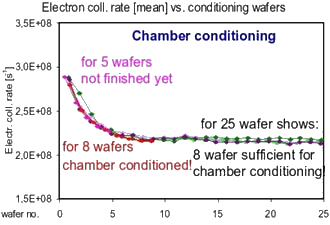

Chamber Conditioning: Why, When, and How?
| The deposition of byproducts on the chamber wall is
unavoidable. The resulting layers affect the process. So a stable
process needs a stable chamber wall conditioning. The conditioning procedure is performed to return the process chamber to production status after:
To condition the chamber, special conditioning wafers (oxide, blanket, resist, and other) are being processed. Depending on tool and product, the quantity of these conditioning wafers is usually fixed and determined empirically. After that, the following tests will be done:
If these tests are successful, the chamber can be returned to production status ( chamber is 'up'). Determination of true conditioning state of the chamber by means of tool parameters is not easy, and only plasma parameters (electron collision rate) are sensitive enough to show the conditioning state. Therefore, plasma parameters are better suited to optimize the conditioning process than tool parameters. |
| Although it
depends on process and tool, the mean of the
electron collision rate typically follows the graph as
shown in the diagram below. |
|
 |
Plasma parameters
are very
sensitive indicators for conditioning completion. This example
shows a stable electron collision
rate
after 7-8 wafers, which means conditioning is complete.
Additional tests should be done to validate the conditioning status:
The results of the SEM wafers are very important because they were processed under real process conditions. Testing the etch rate provides the chamber status roughly only, as process conditions are different than normal conditions (open area, structures, process length, etc.). |
Result of Conditioning Optimization
|
If the CDs of the SEM-wafers and the etch rate uniformity are within specifications after the plasma parameters have reached a steady state, further conditioning wafers can be saved. Dynamic conditioning ! In this example: Only 8 conditioning wafers are needed instead if of 15 or 25 ! If the etch rate uniformity is out of spec after the plasma parameters have reached a steady state, a hardware problem is the likely cause of the problem (flow restrictor, focus ring, …). |